A MMP is a tool that collects attribution data and assesses how well a campaign is doing on various advertising channels.
Why do you need an MMP?
In essence, any advertiser aiming to expand their marketing efforts needs an MMP.
As your user-acquisition campaigns grow and you start to incorporate diverse marketing channels, attempting to analyze data across various ad network dashboards becomes impractical. An MMP is essential for normalizing this data, especially considering the variations in metric calculations among different ad networks.
In an attempt to minimize costs, advertisers adopt a "risk-averse" approach by limiting their user-acquisition campaigns to just one or two ad networks, and rely solely on the respective ad network dashboards for data comparison. However, we argue that such a strategy may lead to negative outcomes. In the event that one or both channels start to underperform, the advertiser would find themselves in a challenging situation.
Therefore, we strongly recommend advertisers to consistently experiment with different channels to enhance their overall strategy. And in doing so, incorporate an MMP in their tech stack to help them normalize the data coming from the different channels.
How does an MMP work?
A crucial role performed by MMPs involves accurately and impartially attributing app installs to specific ad networks. Below are simple illustrations of what the process looks like for install attribution for approximately 80% of the ad networks.
For simplicity’s sake, we have broken down the process into two parts:
- The steps that take place before a user clicks on an ad
- The steps that take place after a user clicks on an ad
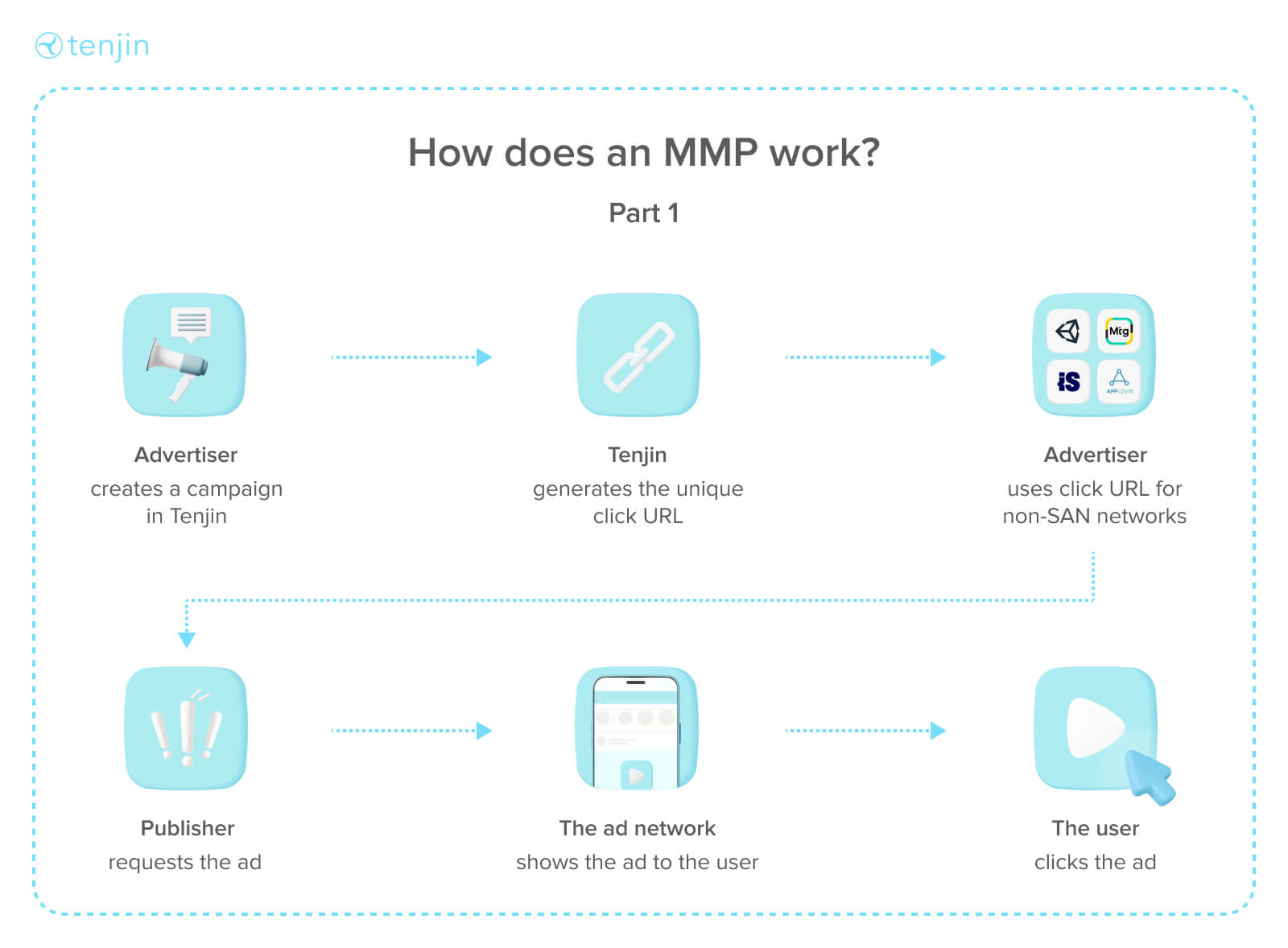
Before we get started on explaining the images themselves, let’s first talk about each of the parties included in the diagram above.
We have:
- The Advertiser: This party owns the app featured in the ad, ideally leading to a user installing it
- The MMP: This party collects attribution data for the advertiser, and helps them assess how well a campaign is doing on various advertising channels
- The Publisher: This party provides the space for the advertiser to run ads inside their app
- The ad network: This party acts as an intermediary between the publisher and the advertiser. Their job is to match the ad supply from the publishers to the demand from the advertisers.
- The User: This party is being targeted with the advertiser’s ads. The goal, or best case scenario for the advertiser, is for this party to install the advertiser's app through these targeted ads.
Now let’s dive into what’s happening in Part 1 of the process. The first step is for the advertiser to create a campaign (or campaigns) in Tenjin, or whatever MMP they are using. The MMP will then generate unique click tracking URLs or deep links that can be used for non-SAN networks or custom channels. This is so the MMP can measure when the user clicks on an ad shown by an ad network.
Next, the publisher app requests an ad from the ad network. The ad network then serves the ad
For the sake of this example, we assume that the ad is clicked by the user inside the publisher app.
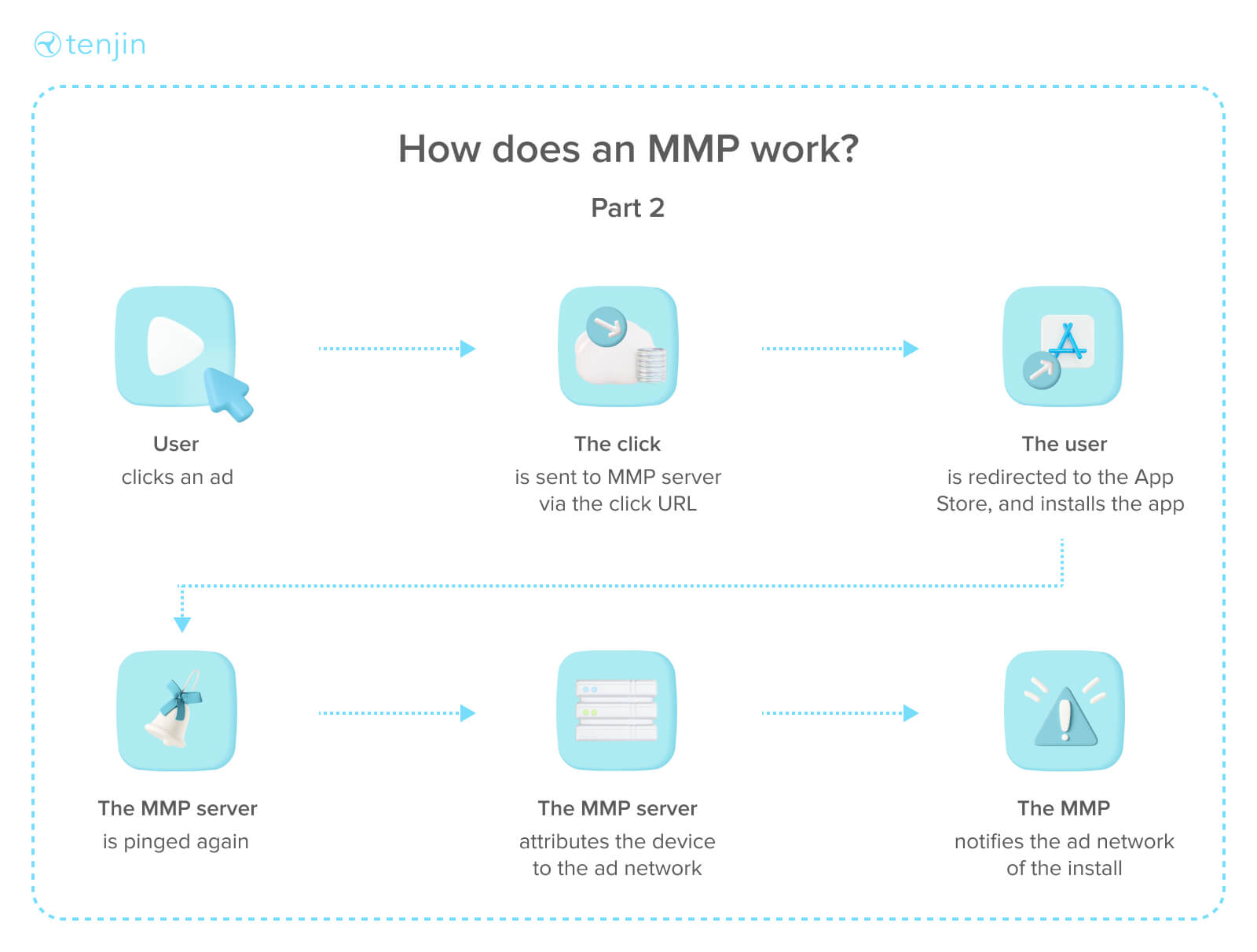
When the user clicks on the ad, the Tenjin (or MMP) server is notified. The user is then redirected to the App Store. In the event that the user ends up installing the app, the MMP server is pinged again, and attributes a device to a specific ad network, and notifies the ad network of the install.
What are the benefits of working with an MMP?
MMP’s empower advertisers to get a unified view of all their marketing data
Using an MMP ensures that you view all your marketing data in one unified view from all your marketing channels, including online and offline sources. This helps users identify their top-performing channels, i.e. those with the highest conversion rates.
An MMP ensures accurate attribution of installs, empowering advertisers to optimize campaigns and maximize ROI
The task of accurately attributing installs that we have elaborated on above holds significant importance for app marketers, as they rely on precise data to identify the most effective channels and ad networks driving conversions. Ultimately, this information guides their investment decisions, enabling them to allocate resources wisely to maximize their ROI.
In simpler terms, MMP’s help advertisers answer the question “Which channels have the best ROI?”
MMPs are able to do this using a combination of methods such as utilizing unique device IDs for individual user attribution, employing probabilistic modeling, and incorporating SKAdNetwork post iOS 14 for deterministic aggregated level attribution for all iOS 14.5+ users.
MMPs, employing models like last-click attribution, ensure advertisers pay only the ad network credited with the install, rather than all ad networks the user interacted with
The average user usually clicks on ads from different ad networks. As an example, let’s say the user clicked on a Mintegral campaign, as well as a Google Ads campaign that led them to the same app. He/she can only be associated with one of those campaigns. According to the last click attribution model used by Tenjin, that user is then associated with the last ad they clicked on.
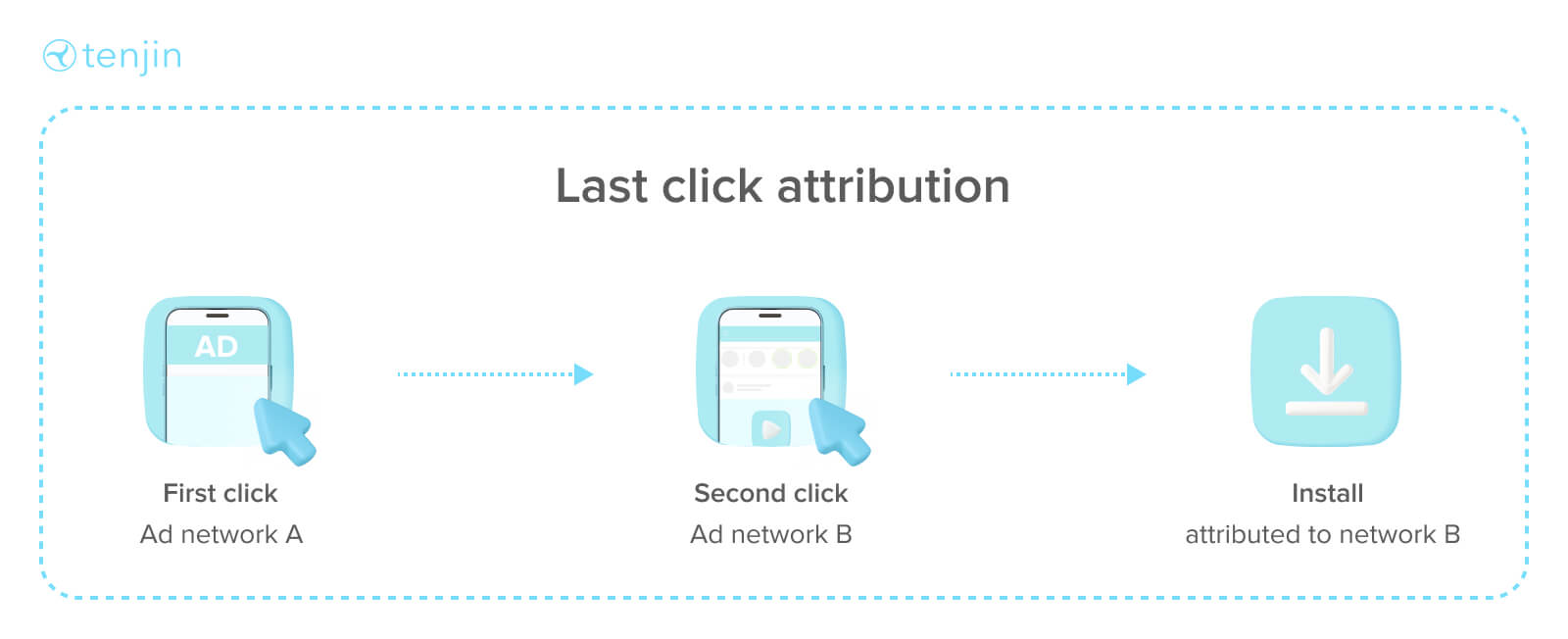
For simplicity’s sake, let’s break this entire process down using a timeline (illustrated below). The user first interacts by clicking on a Mintegral ad. They check the app, but do not download it. Later on, they come across a Google ads ad for the same app. This time, they downloaded the app. According to the last click attribution model, this install is attributed to Google Ads, and all the events get tied to this Google Ads campaign through that user.
Examples of such events are when that user buys something in the app i.e. makes an in-app purchase (IAP), clicks on an in-app advertisement (IAA), or completes a level in a game.
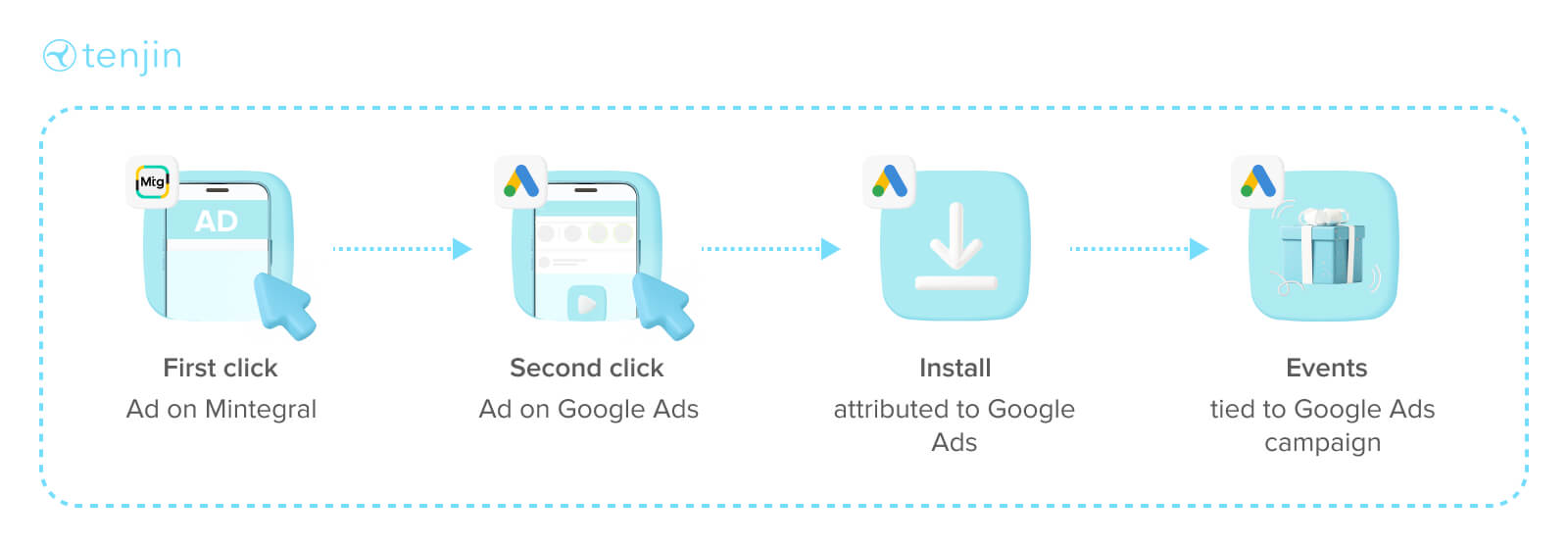
The role of attribution is important here, because in such a case advertisers would only want to pay Google Ads, not Mintegral - because they did not give them the install.

In the past, when there was no attribution, advertisers would be paying both Mintegral, and Google Ads. So to revise, one of the key benefits of working with an MMP or an attribution provider is that they assign a user to a specific ad network.
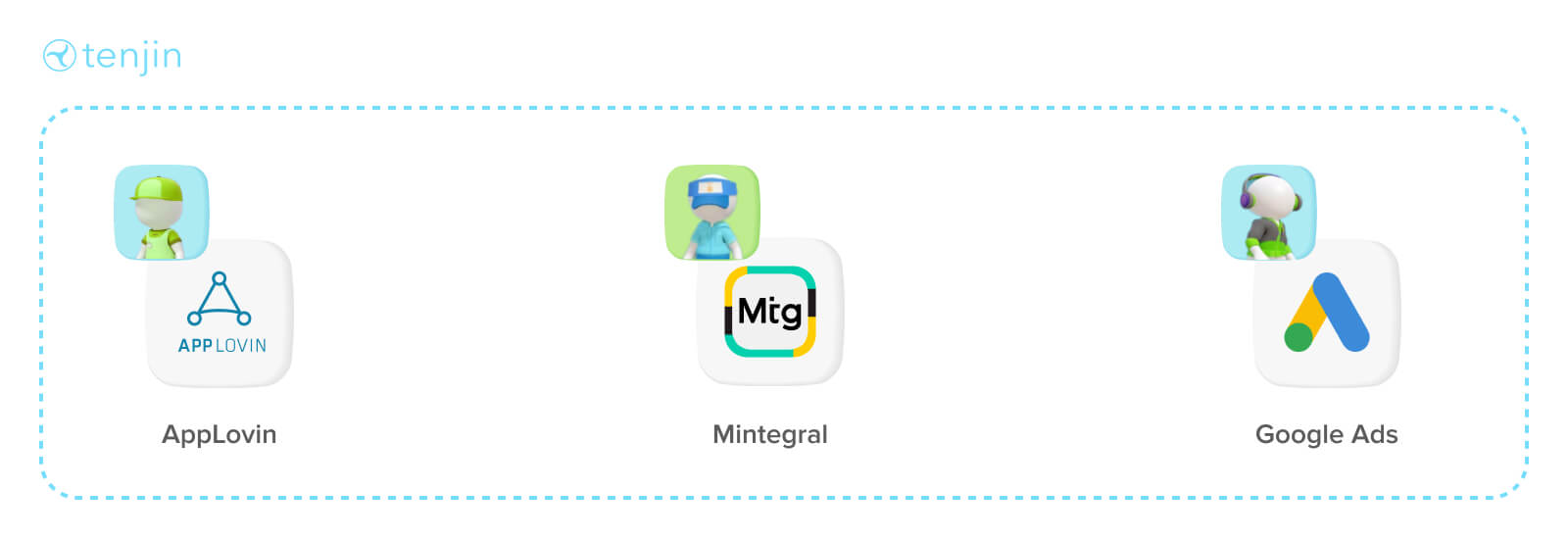
An MMP eliminates the need for integrating multiple channel SDKs, since you only need to integrate one MMP SDK
Another key benefit of using an MMP is that as an advertiser that is advertising on different channels, you only need to integrate one SDK—which is the third-party MMP SDK. You don’t need to integrate different channel SDK’s.
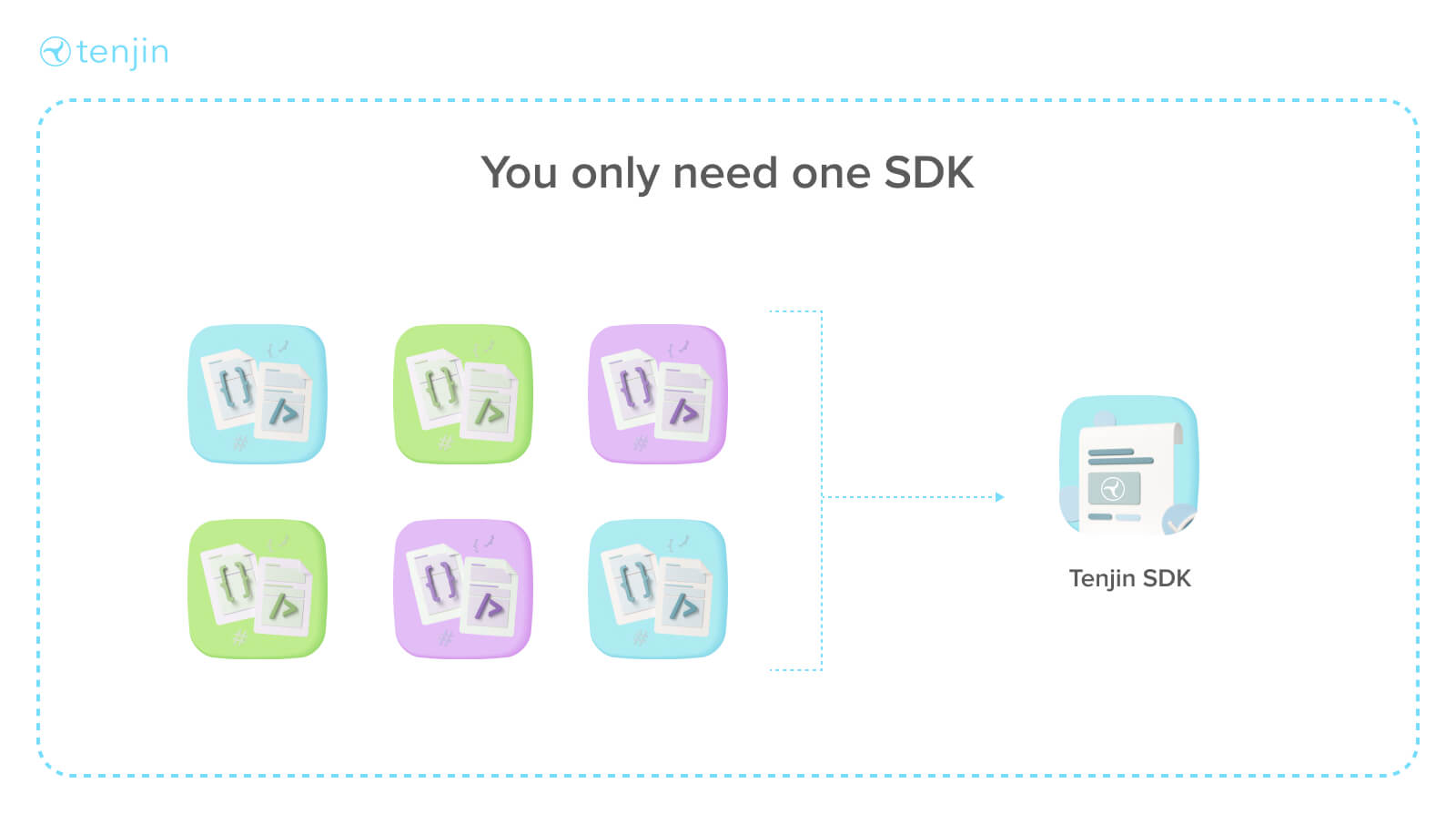
How to choose an MMP?
Even though the core functions of all MMP’s (attribution) are the same, additional features that are often referred to as “add-ons” that they offer are completely different. This makes choosing the right MMP for your business seem like a daunting task at first, but it can be made simple by following some of our tips and best practices below:
- List your priorities and goals for the MMP, considering features, support, and budget.
- Explore different MMP websites, especially their pricing pages, for key information. At this point, it is important to understand that a lot of times it may seem like you are getting all the features and products in a specific plan. However, it is important to cross-check what you are going to have access to, and what you would need to pay additionally for. Are all the features you have listed in the first point being offered in a certain plan? Have you also considered the features you don’t need right now, but may want to incorporate in the future?
- Remember, a relationship with an MMP is likely a more of a long term commitment for most people. Therefore, it is important to think about what features you may need in the future as well. As an example, incorporating ROAS campaigns might not make sense for you and your business right now, but you might want to check with the MMP and understand the additional costs associated with it in case you want to incorporate them in the future. Most MMP’s will charge additionally for a lot of these features. Tenjin provides a full list of features you can look into if you scroll down on our pricing page.
- Schedule demos with the shortlisted MMPs to address specific business needs, and get answers to all the questions you have gathered in points 1 and 2.
- Try free trials or sign up for free plans with your selected MMPs, integrating their SDKs for testing: To the best of our knowledge, most MMP’s offer generous free trials to help users understand their platform and choose accordingly. Tenjin’s free plan, for example, grants users 2000 free attributions a month (or 24000 free attributions a year). The plan also includes unlimited organic installs, ad spend and ad revenue reporting, SKAdNetwork reporting, and more.
What is the best way to start using Tenjin as my MMP?
We have made the process of starting to use Tenjin as easy as possible for users. With our all-inclusive plans, mobile marketers are able to get flat and transparent pricing that is not available anywhere else in the market.
Additionally, our self-service platform ensures that you can sign up for free whenever you want and enjoy using our Free Plan with 2,000 attributions per month.
Additionally, we offer detailed and personalized demos from your personal Account Executive to anyone who needs it. You can book a demo with us on our website www.tenjin.com.
What makes Tenjin unique?
Pricing: Tenjin is the only MMP that is offering flat monthly pricing that includes all Tenjin products, and no hidden fees. We came up with this pricing in response to the adjustments made in Unity’s pricing policy on 12th September 2023. It got us thinking, and we decided to make some changes to our own pricing to help mobile marketers worldwide.
We know that pricing in our industry can be a real pain, and we've heard from users who were not too happy about always having to pay large sums for each additional product they want to incorporate.
To make things easier, we rolled out all-inclusive plans that cover all Tenjin products for a flat price. These plans start at just $200 for up to 10,000 attributions per month, making it the most competitive price in the industry.
You'll get everything, from Ad revenue callbacks for ROAS campaigns and LiveOps Campaigns to data warehouse access, raw data export, automated data pipelines, and more.
You can learn about these all-inclusive plans here.
Support: We pride ourselves on quick turnaround times and personalized support. Upon sign-up, each business, including those on our free plan, is assigned a personal account executive who guides users through integration and promptly addresses any queries.
Tools: We constantly upgrade our tools to make sure that they not only follow industry trends, but are also accessible to teams of all sizes.
Products: All Tenjin users can access DataVault, a dedicated data warehouse. Additionally, our ETL (or automated data pipeline) service, Growth FullStack, enables users to merge data from various third-party tools in their tech stack, facilitating deeper analysis of their data.
In light of privacy-first changes, we consider these products crucial for users to analyze data in unique ways, and stay ahead of competitors.
What is the best way to contact Tenjin?
If you’ve read this article and have related questions, you can reach out to us by emailing us at suppot@tenjin.com with the subject line “Questions on your MMP article.” We’re excited to hear from you!